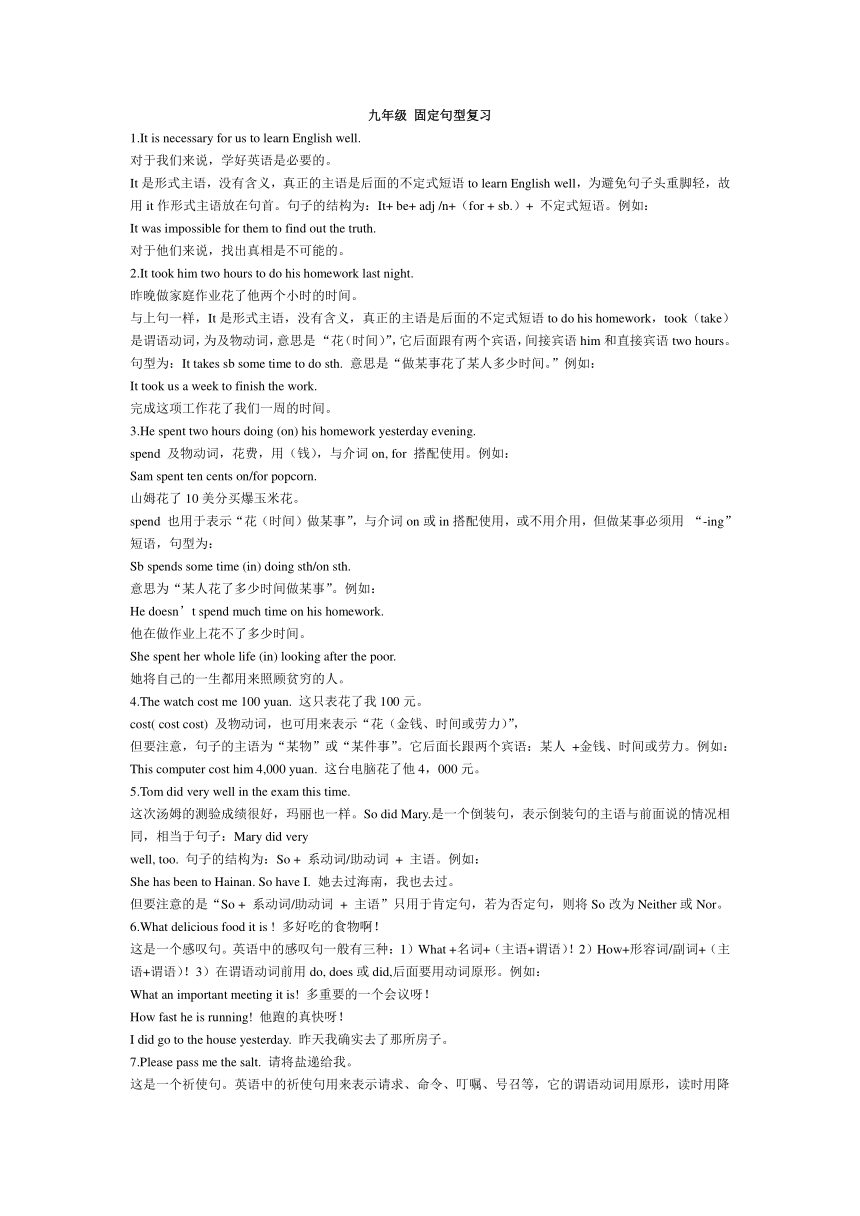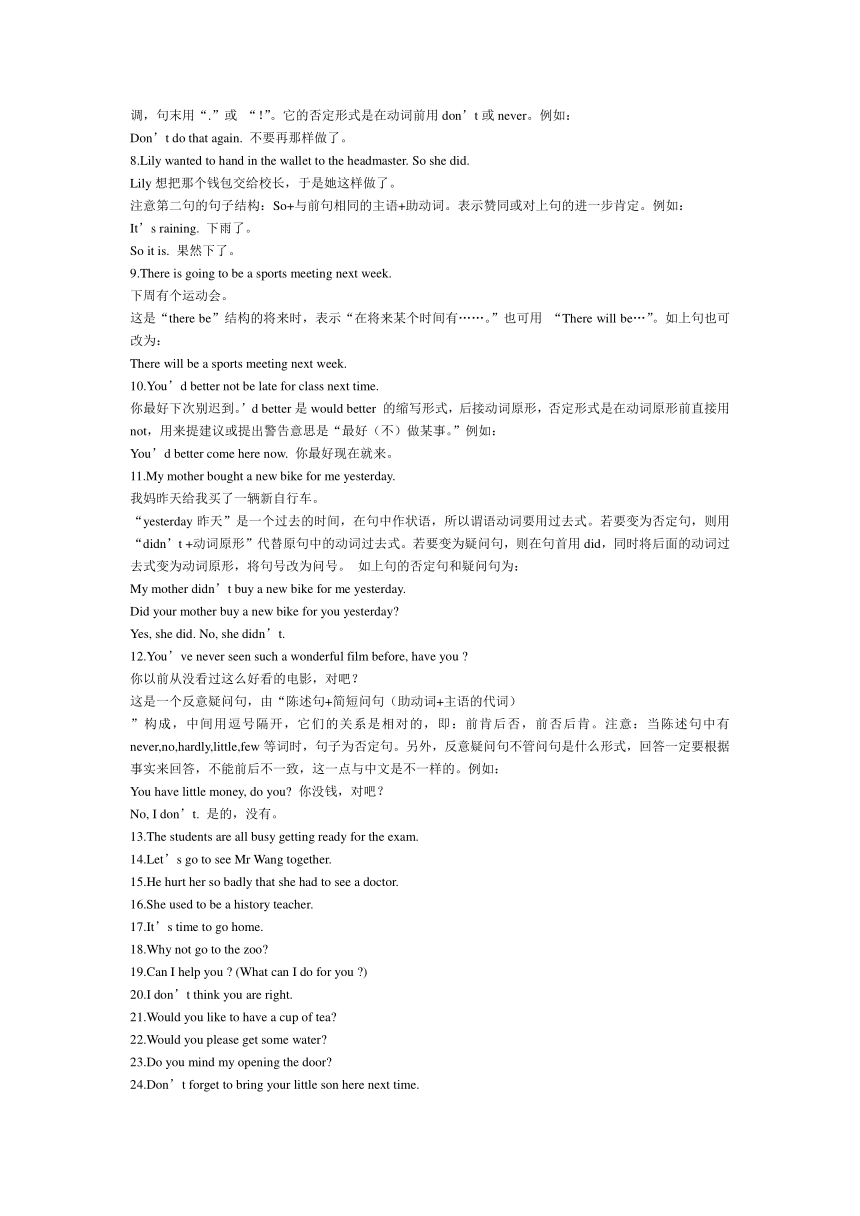九年级 固定句型复习[下学期]
图片预览


文档简介
九年级 固定句型复习
1.It is necessary for us to learn English well.
对于我们来说,学好英语是必要的。
It是形式主语,没有含义,真正的主语是后面的不定式短语to learn English well,为避免句子头重脚轻,故用it作形式主语放在句首。句子的结构为:It+ be+ adj /n+(for + sb.)+ 不定式短语。例如:
It was impossible for them to find out the truth.
对于他们来说,找出真相是不可能的。
2.It took him two hours to do his homework last night.
昨晚做家庭作业花了他两个小时的时间。
与上句一样,It是形式主语,没有含义,真正的主语是后面的不定式短语to do his homework,took(take)是谓语动词,为及物动词,意思是 “花(时间)”,它后面跟有两个宾语,间接宾语him和直接宾语two hours。句型为:It takes sb some time to do sth. 意思是“做某事花了某人多少时间。”例如:
It took us a week to finish the work.
完成这项工作花了我们一周的时间。
3.He spent two hours doing (on) his homework yesterday evening.
spend 及物动词,花费,用(钱),与介词on, for 搭配使用。例如:
Sam spent ten cents on/for popcorn.
山姆花了10美分买爆玉米花。
spend 也用于表示“花(时间)做某事”,与介词on或in搭配使用,或不用介用,但做某事必须用 “-ing”短语,句型为:
Sb spends some time (in) doing sth/on sth.
意思为“某人花了多少时间做某事”。例如:
He doesn’t spend much time on his homework.
他在做作业上花不了多少时间。
She spent her whole life (in) looking after the poor.
她将自己的一生都用来照顾贫穷的人。
4.The watch cost me 100 yuan. 这只表花了我100元。
cost( cost cost) 及物动词,也可用来表示“花(金钱、时间或劳力)”,
但要注意,句子的主语为“某物”或“某件事”。它后面长跟两个宾语:某人 +金钱、时间或劳力。例如:
This computer cost him 4,000 yuan. 这台电脑花了他4,000元。
5.Tom did very well in the exam this time.
这次汤姆的测验成绩很好,玛丽也一样。So did Mary.是一个倒装句,表示倒装句的主语与前面说的情况相同,相当于句子:Mary did very
well, too. 句子的结构为:So + 系动词/助动词 + 主语。例如:
She has been to Hainan. So have I. 她去过海南,我也去过。
但要注意的是“So + 系动词/助动词 + 主语”只用于肯定句,若为否定句,则将So改为Neither或Nor。
6.What delicious food it is ! 多好吃的食物啊!
这是一个感叹句。英语中的感叹句一般有三种:1)What +名词+(主语+谓语)!2)How+形容词/副词+(主语+谓语)!3)在谓语动词前用do, does或did,后面要用动词原形。例如:
What an important meeting it is! 多重要的一个会议呀!
How fast he is running! 他跑的真快呀!
I did go to the house yesterday. 昨天我确实去了那所房子。
7.Please pass me the salt. 请将盐递给我。
这是一个祈使句。英语中的祈使句用来表示请求、命令、叮嘱、号召等,它的谓语动词用原形,读时用降调,句末用“.”或 “!”。它的否定形式是在动词前用don’t或never。例如:
Don’t do that again. 不要再那样做了。
8.Lily wanted to hand in the wallet to the headmaster. So she did.
Lily想把那个钱包交给校长,于是她这样做了。
注意第二句的句子结构:So+与前句相同的主语+助动词。表示赞同或对上句的进一步肯定。例如:
It’s raining. 下雨了。
So it is. 果然下了。
9.There is going to be a sports meeting next week.
下周有个运动会。
这是“there be”结构的将来时,表示“在将来某个时间有……。”也可用 “There will be…”。如上句也可改为:
There will be a sports meeting next week.
10.You’d better not be late for class next time.
你最好下次别迟到。’d better是would better 的缩写形式,后接动词原形,否定形式是在动词原形前直接用not,用来提建议或提出警告意思是“最好(不)做某事。”例如:
You’d better come here now. 你最好现在就来。
11.My mother bought a new bike for me yesterday.
我妈昨天给我买了一辆新自行车。
“yesterday昨天”是一个过去的时间,在句中作状语,所以谓语动词要用过去式。若要变为否定句,则用“didn’t +动词原形”代替原句中的动词过去式。若要变为疑问句,则在句首用did,同时将后面的动词过去式变为动词原形,将句号改为问号。 如上句的否定句和疑问句为:
My mother didn’t buy a new bike for me yesterday.
Did your mother buy a new bike for you yesterday
Yes, she did. No, she didn’t.
12.You’ve never seen such a wonderful film before, have you
你以前从没看过这么好看的电影,对吧?
这是一个反意疑问句,由“陈述句+简短问句(助动词+主语的代词)
”构成,中间用逗号隔开,它们的关系是相对的,即:前肯后否,前否后肯。注意:当陈述句中有never,no,hardly,little,few等词时,句子为否定句。另外,反意疑问句不管问句是什么形式,回答一定要根据事实来回答,不能前后不一致,这一点与中文是不一样的。例如:
You have little money, do you 你没钱,对吧?
No, I don’t. 是的,没有。
13.The students are all busy getting ready for the exam.
14.Let’s go to see Mr Wang together.
15.He hurt her so badly that she had to see a doctor.
16.She used to be a history teacher.
17.It’s time to go home.
18.Why not go to the zoo
19.Can I help you (What can I do for you )
20.I don’t think you are right.
21.Would you like to have a cup of tea
22.Would you please get some water
23.Do you mind my opening the door
24.Don’t forget to bring your little son here next time.
25.Neither he nor I like coffee. 我和他都不喜欢咖啡。
26.Either you or he will go to the meeting. 不是你就是他要去开会。
neither A nor B的意思是“非A亦非B” ; either A or B的意思是“非A即B”;both A and B的意思是“AB两者都”;当neither A nor B和either A or B连接的是主语时,谓语动词要与邻近的主语保持一致。例如:
Neither she nor I am right. 她和我都不对。
Either she or I am right. 她和我必有一人对。
Both she and I are right. 她和我都对。
在3个短语中,A和B的结构须一致,例如:
neither hot nor cold 既不热也不冷
either for or against the plan 要么赞成这个计划要么反对
both fame and wealth 名和利
27.Thousands of trees should be planted on the mountains.
应该在山上种很多很多的树。
这是一个被动语态的句子。在英语中,当主语不明或不便于说出时,便用被动语态,它的基本构成是:助动词be + 动词的过去分词。被动语态的时态和与主语如何保持一致都通过助动词be体现出来。例如:This computer is made in Japan. 这台电脑是日本产的。
The rooms have been cleaned. 房间已打扫了。
28.Here comes the bus!
29.There goes the bell!
28和29句都是倒装句。在以there, here, now, then等引起的句子中,谓语动词常为be, come, go等,句子要全倒装,例如:
Now comes your turn. 现在该轮到你了。
如果主语是人称代词则不用。例如:Here they are. 他们在这儿。
30.He’ll go fishing if it doesn’t rain. 如果不下雨的话,他会去钓鱼。
if it doesn’t rain是条件状语从句。在条件状语从句中,要用一般时态代替将来时态,等引导的时间状语从句,也有此特点。例如:
I’ll tell him when he comes back. 他回来时我就告诉他。
31.I found it possible to get there on time. 我发现按时到达那儿是可能的。
find / think + it + adj. + to do sth. 发现 /认为做某事是……。it是形式宾语,真实宾语是to do sth.,相当于一个宾语从句。如上句可改为:
I found (that) it is possible to get there on time.
32.There is something wrong with my bike. 我的自行车有点问题。
wrong 形容词,作定语,修饰不定代词something,不定代词的修饰词必须放在不定代词之后。例如:
Is there anything important in today’s newspaper
今天的报纸上有什么重要消息吗?
33.What’s under the tree 树下有什么?
What’s + 地点? 意思是:在某地(存在)有什么?它的回答一般用
There be 结构。或直接用名词词组。例如:
What’s in the picture 画中有什么?
(There are) some pigs. 几头猪。
34.I’m not rich enough to buy the car. 我不够有钱,买不起那辆车。
(not) + adj /adv + enough + to do sth. (不)够……到可以做某事。
例如:
The boy is old enough to go to school. 这个男孩可以上学了。
35.I’m too tired to go farther. 我太累了走不动了。
too…to… 太……而不能做……。too后接形容词或副词的原形,to
后接动词原形。句子结构相当于:so… that…can’t / couldn’t do…。如上句可改为:I’m so tired that I can’t go any farther.
36.I won’t go to bed until I finish my homework.
我完成了家庭作业后才去睡觉。not…until…, 直到……才……
句子字面意思是:在我完成家庭作业前,我一直没去睡觉。
因为until表示的是一段时间,所以在until之前要么用否定句,构成not…until…,要么用持续性动词。例如:
Don’t get off the bus until it stops. 在车停好后再下车。
I’ll stay at school until mum comes. 我会在学校一直呆到妈妈来。
37.Football is more popular than any other sport in west countries.
在西方国家里,足球比任何其它一种体育运动更普遍。
结构“比较级+ than any other+可数名词的单数”实际上就等于最高级。
如,上句可改为:Football is the most popular sport in west countries.
38.I saw him playing football on the playground.
我看见他在操场上踢足球。
see sb. do / doing sth. 看见某人做某事。若强调动作的全过程或结果,则用see sb. do sth.; 若强调动作在进行过程中或总在重复,则用see sb. doing sth.。象这样使用的动词还有:hear听见,feel感觉,listen to听,look at看,notice注意,watch观看等。例如:
I heard him cough. 我听到他咳嗽。
I heard him coughing when I woke up. 我醒来时听到他正在咳嗽。
39.He teaches us Japanese. 他教我们日语。
teach sb. sth. 教某人某事,sb. sth.是teach的两个宾语,所以用代词时,要用宾格。
40.What makes you think I’m a farmer
是什么让你认为我是个农民的?
make sb. do sth.让某人做某事,象这样用不带to的不定式作宾语补足语的动词还有have, let。例如:
Let me help you. 让我来帮你吧。
41.Please help yourselves to some fish. 请随便吃些鱼吧。
Help oneself to sth. 用于招待客人时,意思为:请随便吃/用点(食物)吧。to 在这里是介词,后接名词或代词。
42.It has kept raining for several days. 雨已下了几天了。
it在这里指的是天气。keep保持,keep doing sth.一直做某事,表示一段时间,用介词for。表示某动作从过去某一时间开始,一直持续到现在,用现在完成时。例如:
I’ve been here for several days. 我来这里好几天了。
43.It’s very kind of you to give me a hand.你能给我帮忙,真是太好了。
句子可改为:You are kind to give a hand.
上句的句子结构为:It’s kind / nice of sb. to do sth.意思为:某人能做某事真是太好了。例如:
It’s nice of him to lend us some money. 他能借钱给我们真好。
44.Jim wants to find a job to make a living. Jim想找份工作以谋生。To make a living不定式作目的状语,相当于in order to make a living; want to do sth.是“想要做某事。
1.It is necessary for us to learn English well.
对于我们来说,学好英语是必要的。
It是形式主语,没有含义,真正的主语是后面的不定式短语to learn English well,为避免句子头重脚轻,故用it作形式主语放在句首。句子的结构为:It+ be+ adj /n+(for + sb.)+ 不定式短语。例如:
It was impossible for them to find out the truth.
对于他们来说,找出真相是不可能的。
2.It took him two hours to do his homework last night.
昨晚做家庭作业花了他两个小时的时间。
与上句一样,It是形式主语,没有含义,真正的主语是后面的不定式短语to do his homework,took(take)是谓语动词,为及物动词,意思是 “花(时间)”,它后面跟有两个宾语,间接宾语him和直接宾语two hours。句型为:It takes sb some time to do sth. 意思是“做某事花了某人多少时间。”例如:
It took us a week to finish the work.
完成这项工作花了我们一周的时间。
3.He spent two hours doing (on) his homework yesterday evening.
spend 及物动词,花费,用(钱),与介词on, for 搭配使用。例如:
Sam spent ten cents on/for popcorn.
山姆花了10美分买爆玉米花。
spend 也用于表示“花(时间)做某事”,与介词on或in搭配使用,或不用介用,但做某事必须用 “-ing”短语,句型为:
Sb spends some time (in) doing sth/on sth.
意思为“某人花了多少时间做某事”。例如:
He doesn’t spend much time on his homework.
他在做作业上花不了多少时间。
She spent her whole life (in) looking after the poor.
她将自己的一生都用来照顾贫穷的人。
4.The watch cost me 100 yuan. 这只表花了我100元。
cost( cost cost) 及物动词,也可用来表示“花(金钱、时间或劳力)”,
但要注意,句子的主语为“某物”或“某件事”。它后面长跟两个宾语:某人 +金钱、时间或劳力。例如:
This computer cost him 4,000 yuan. 这台电脑花了他4,000元。
5.Tom did very well in the exam this time.
这次汤姆的测验成绩很好,玛丽也一样。So did Mary.是一个倒装句,表示倒装句的主语与前面说的情况相同,相当于句子:Mary did very
well, too. 句子的结构为:So + 系动词/助动词 + 主语。例如:
She has been to Hainan. So have I. 她去过海南,我也去过。
但要注意的是“So + 系动词/助动词 + 主语”只用于肯定句,若为否定句,则将So改为Neither或Nor。
6.What delicious food it is ! 多好吃的食物啊!
这是一个感叹句。英语中的感叹句一般有三种:1)What +名词+(主语+谓语)!2)How+形容词/副词+(主语+谓语)!3)在谓语动词前用do, does或did,后面要用动词原形。例如:
What an important meeting it is! 多重要的一个会议呀!
How fast he is running! 他跑的真快呀!
I did go to the house yesterday. 昨天我确实去了那所房子。
7.Please pass me the salt. 请将盐递给我。
这是一个祈使句。英语中的祈使句用来表示请求、命令、叮嘱、号召等,它的谓语动词用原形,读时用降调,句末用“.”或 “!”。它的否定形式是在动词前用don’t或never。例如:
Don’t do that again. 不要再那样做了。
8.Lily wanted to hand in the wallet to the headmaster. So she did.
Lily想把那个钱包交给校长,于是她这样做了。
注意第二句的句子结构:So+与前句相同的主语+助动词。表示赞同或对上句的进一步肯定。例如:
It’s raining. 下雨了。
So it is. 果然下了。
9.There is going to be a sports meeting next week.
下周有个运动会。
这是“there be”结构的将来时,表示“在将来某个时间有……。”也可用 “There will be…”。如上句也可改为:
There will be a sports meeting next week.
10.You’d better not be late for class next time.
你最好下次别迟到。’d better是would better 的缩写形式,后接动词原形,否定形式是在动词原形前直接用not,用来提建议或提出警告意思是“最好(不)做某事。”例如:
You’d better come here now. 你最好现在就来。
11.My mother bought a new bike for me yesterday.
我妈昨天给我买了一辆新自行车。
“yesterday昨天”是一个过去的时间,在句中作状语,所以谓语动词要用过去式。若要变为否定句,则用“didn’t +动词原形”代替原句中的动词过去式。若要变为疑问句,则在句首用did,同时将后面的动词过去式变为动词原形,将句号改为问号。 如上句的否定句和疑问句为:
My mother didn’t buy a new bike for me yesterday.
Did your mother buy a new bike for you yesterday
Yes, she did. No, she didn’t.
12.You’ve never seen such a wonderful film before, have you
你以前从没看过这么好看的电影,对吧?
这是一个反意疑问句,由“陈述句+简短问句(助动词+主语的代词)
”构成,中间用逗号隔开,它们的关系是相对的,即:前肯后否,前否后肯。注意:当陈述句中有never,no,hardly,little,few等词时,句子为否定句。另外,反意疑问句不管问句是什么形式,回答一定要根据事实来回答,不能前后不一致,这一点与中文是不一样的。例如:
You have little money, do you 你没钱,对吧?
No, I don’t. 是的,没有。
13.The students are all busy getting ready for the exam.
14.Let’s go to see Mr Wang together.
15.He hurt her so badly that she had to see a doctor.
16.She used to be a history teacher.
17.It’s time to go home.
18.Why not go to the zoo
19.Can I help you (What can I do for you )
20.I don’t think you are right.
21.Would you like to have a cup of tea
22.Would you please get some water
23.Do you mind my opening the door
24.Don’t forget to bring your little son here next time.
25.Neither he nor I like coffee. 我和他都不喜欢咖啡。
26.Either you or he will go to the meeting. 不是你就是他要去开会。
neither A nor B的意思是“非A亦非B” ; either A or B的意思是“非A即B”;both A and B的意思是“AB两者都”;当neither A nor B和either A or B连接的是主语时,谓语动词要与邻近的主语保持一致。例如:
Neither she nor I am right. 她和我都不对。
Either she or I am right. 她和我必有一人对。
Both she and I are right. 她和我都对。
在3个短语中,A和B的结构须一致,例如:
neither hot nor cold 既不热也不冷
either for or against the plan 要么赞成这个计划要么反对
both fame and wealth 名和利
27.Thousands of trees should be planted on the mountains.
应该在山上种很多很多的树。
这是一个被动语态的句子。在英语中,当主语不明或不便于说出时,便用被动语态,它的基本构成是:助动词be + 动词的过去分词。被动语态的时态和与主语如何保持一致都通过助动词be体现出来。例如:This computer is made in Japan. 这台电脑是日本产的。
The rooms have been cleaned. 房间已打扫了。
28.Here comes the bus!
29.There goes the bell!
28和29句都是倒装句。在以there, here, now, then等引起的句子中,谓语动词常为be, come, go等,句子要全倒装,例如:
Now comes your turn. 现在该轮到你了。
如果主语是人称代词则不用。例如:Here they are. 他们在这儿。
30.He’ll go fishing if it doesn’t rain. 如果不下雨的话,他会去钓鱼。
if it doesn’t rain是条件状语从句。在条件状语从句中,要用一般时态代替将来时态,等引导的时间状语从句,也有此特点。例如:
I’ll tell him when he comes back. 他回来时我就告诉他。
31.I found it possible to get there on time. 我发现按时到达那儿是可能的。
find / think + it + adj. + to do sth. 发现 /认为做某事是……。it是形式宾语,真实宾语是to do sth.,相当于一个宾语从句。如上句可改为:
I found (that) it is possible to get there on time.
32.There is something wrong with my bike. 我的自行车有点问题。
wrong 形容词,作定语,修饰不定代词something,不定代词的修饰词必须放在不定代词之后。例如:
Is there anything important in today’s newspaper
今天的报纸上有什么重要消息吗?
33.What’s under the tree 树下有什么?
What’s + 地点? 意思是:在某地(存在)有什么?它的回答一般用
There be 结构。或直接用名词词组。例如:
What’s in the picture 画中有什么?
(There are) some pigs. 几头猪。
34.I’m not rich enough to buy the car. 我不够有钱,买不起那辆车。
(not) + adj /adv + enough + to do sth. (不)够……到可以做某事。
例如:
The boy is old enough to go to school. 这个男孩可以上学了。
35.I’m too tired to go farther. 我太累了走不动了。
too…to… 太……而不能做……。too后接形容词或副词的原形,to
后接动词原形。句子结构相当于:so… that…can’t / couldn’t do…。如上句可改为:I’m so tired that I can’t go any farther.
36.I won’t go to bed until I finish my homework.
我完成了家庭作业后才去睡觉。not…until…, 直到……才……
句子字面意思是:在我完成家庭作业前,我一直没去睡觉。
因为until表示的是一段时间,所以在until之前要么用否定句,构成not…until…,要么用持续性动词。例如:
Don’t get off the bus until it stops. 在车停好后再下车。
I’ll stay at school until mum comes. 我会在学校一直呆到妈妈来。
37.Football is more popular than any other sport in west countries.
在西方国家里,足球比任何其它一种体育运动更普遍。
结构“比较级+ than any other+可数名词的单数”实际上就等于最高级。
如,上句可改为:Football is the most popular sport in west countries.
38.I saw him playing football on the playground.
我看见他在操场上踢足球。
see sb. do / doing sth. 看见某人做某事。若强调动作的全过程或结果,则用see sb. do sth.; 若强调动作在进行过程中或总在重复,则用see sb. doing sth.。象这样使用的动词还有:hear听见,feel感觉,listen to听,look at看,notice注意,watch观看等。例如:
I heard him cough. 我听到他咳嗽。
I heard him coughing when I woke up. 我醒来时听到他正在咳嗽。
39.He teaches us Japanese. 他教我们日语。
teach sb. sth. 教某人某事,sb. sth.是teach的两个宾语,所以用代词时,要用宾格。
40.What makes you think I’m a farmer
是什么让你认为我是个农民的?
make sb. do sth.让某人做某事,象这样用不带to的不定式作宾语补足语的动词还有have, let。例如:
Let me help you. 让我来帮你吧。
41.Please help yourselves to some fish. 请随便吃些鱼吧。
Help oneself to sth. 用于招待客人时,意思为:请随便吃/用点(食物)吧。to 在这里是介词,后接名词或代词。
42.It has kept raining for several days. 雨已下了几天了。
it在这里指的是天气。keep保持,keep doing sth.一直做某事,表示一段时间,用介词for。表示某动作从过去某一时间开始,一直持续到现在,用现在完成时。例如:
I’ve been here for several days. 我来这里好几天了。
43.It’s very kind of you to give me a hand.你能给我帮忙,真是太好了。
句子可改为:You are kind to give a hand.
上句的句子结构为:It’s kind / nice of sb. to do sth.意思为:某人能做某事真是太好了。例如:
It’s nice of him to lend us some money. 他能借钱给我们真好。
44.Jim wants to find a job to make a living. Jim想找份工作以谋生。To make a living不定式作目的状语,相当于in order to make a living; want to do sth.是“想要做某事。
同课章节目录
